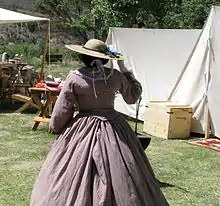Prairie skirt
A prairie skirt is an American style of skirt, an article of women's and girls' clothing.

Prairie skirts are slightly flared to very full, with one or more flounces (deep ruffles) or tiers, and are often worn over a ruffled eyelet or lace-trimmed petticoat. In keeping with their design inspiration, traditional prairie skirts are usually made of "country" fabrics such as denim and flowered calico. Prairie skirts are a staple of women's western wear, and very full prairie skirts are worn for square dancing.
Origins in the 19th century
Prairie skirts are so-called after their resemblance to the home-sewn skirts worn by pioneer women in the mid-19th century,[1] which in turn are a simplified version of the flared, ruffled skirts characteristic of high-fashion dresses of the 1820s. The style originated as an adaptation of high fashion to the practicalities of rural life in the Western United States. Deep colors and prints were used as they did not show dirt, while decorations were used to update clothing to changing fashions. [2]
Revival in the 1960s and 1970s
Counterculture Hippies rejecting mainstream fashion looking instead to historical and non-Western styles. While 19th century prairie clothing was usually homemade, new companies such as Gunne Sax in San Francisco began manufacturing ready to wear prairie clothing. The style grew in popularity in the 1970s with the approach of the United States Bicentennial and was introduced to high fashion by Ralph Lauren in his fall 1978 Western-themed collection.[3]
Mid-calf length, button-front denim prairie skirts with a single flounce, worn with a 1950s-style petticoat that was slightly longer than the skirt, became a mainstream fashion in the 1970s and early 1980s following Lauren's introduction.[3]
 Late 1970s prairie dress
Late 1970s prairie dress Collar of a 1970s prairie dress, showing common parts of the style such as lace, buttons, floral fabric, and ruffles.
Collar of a 1970s prairie dress, showing common parts of the style such as lace, buttons, floral fabric, and ruffles. 1970s prairie dresses
1970s prairie dresses
21st century
Short, many-tiered prairie skirts of voile, chiffon or other lightweight fabrics were a fashion trend in 2005. Some wear longer-length prairie skirts with a slip or underskirt to preserve their modesty. Prairie dresses were again a fashion trend in the late 2010s, and were part of the cottagecore trend in 2020.[4]
Notes
- Tortora, Phyllis G.; Keiser, Sandra J. (2013). The Fairchild Books dictionary of fashion (4th ed.). New York, NY, USA. p. 373. ISBN 978-1-60901-489-6. OCLC 862092495.
- "Sutter's Fort Clothing - 1840s" (PDF). California State Parks. Retrieved 28 February 2015.
- George-Warren, Holly, and Michelle Freedman: How the West Was Worn, p. 184-187.
- "Why Cottagecore and Prairie Dressing Are Fashion's Biggest Trends in 2020". Teen Vogue. Retrieved 31 January 2021.
References
- George-Warren, Holly, and Michelle Freedman: How the West Was Worn, Harry N. Abrams (2001), ISBN 0-8109-0615-5.